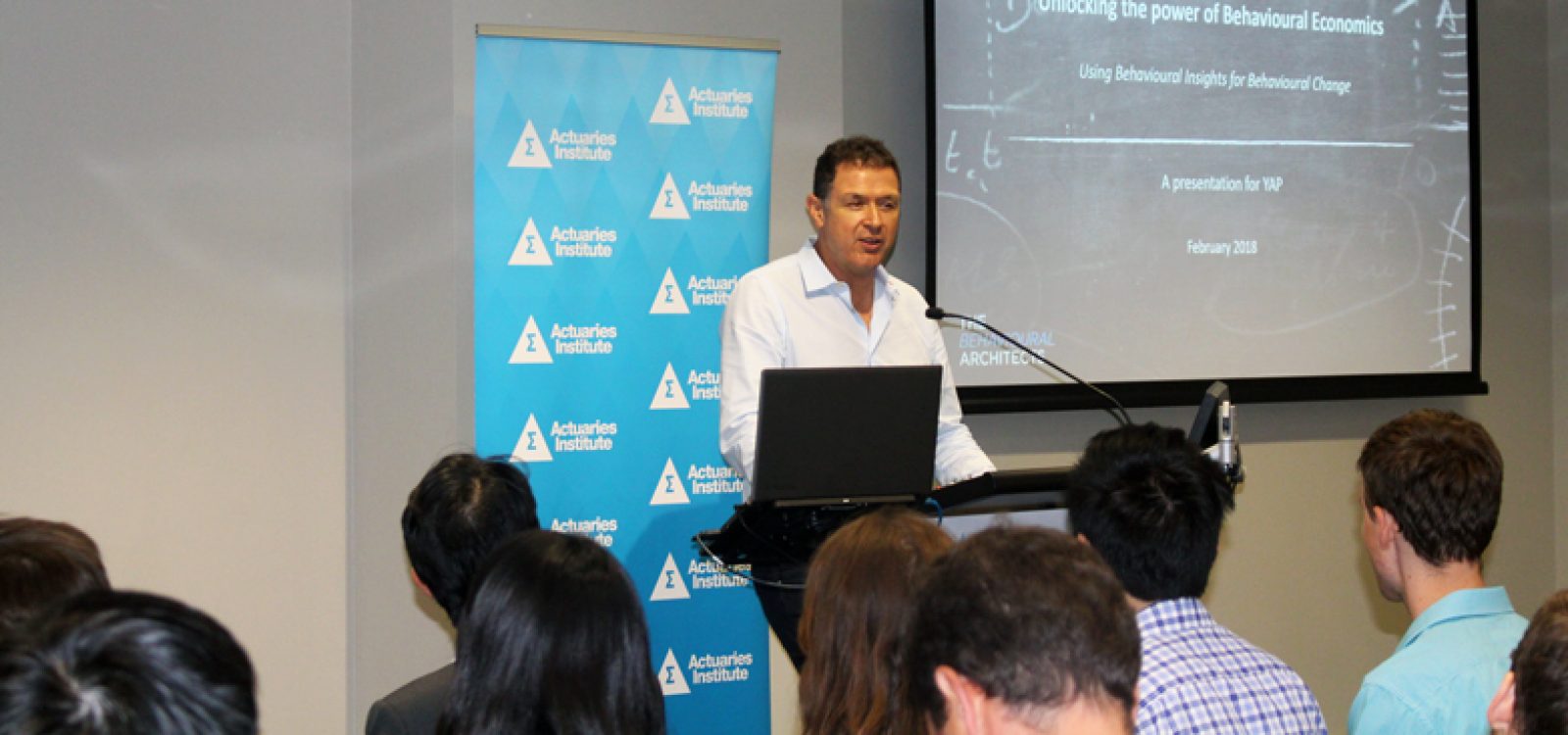
The power of the nudge – A Young Actuaries Program event report
Chris Wong reports on this month’s Young Actuaries Program (YAP) session on Behavioural Economics, where Mike Daniels of the Behavioural Architects delved into the power of context, bias and subconscious in how we make decisions.

Previously thought to only be of interest to psychologist and academics, the study of Behavioural Economics (BE) has seen greater acceptance and application across many disciplines. Having personally seen it permeate the world of marketing for the past decade, I decided to attend an introduction to Behavioural Economics to the Young Actuaries Program (YAP) in Sydney by Mike Daniels, Founder of The Behavioural Architects. I was curious to see how an audience of actuaries, stereotyped to prefer cold, hard logic over subjective examination, would respond to Mike’s primary subject matter of emotions and personal biases.
Over the course of just over an hour, Mike walked his audience through 4 key principles that he has built his advisory business on. I’ll do my best to try and summarise them.
Subconscious choices
The 1st Principle suggests much of our behaviour is subconscious
The primary sentiment is that “most people do not know why they do most of the things they do”. This clearly creates issues, as most of traditional market research relies heavily on declared responses rather than observation. This is fundamental to the study of behaviour, which Mike emphasises – can’t be explained by people in an outward manner and needs to rely on the designing of research that emphasises observation of its subjects.
The “Dual System Theory”
The 2nd Principle delved into how people process information through the framework of the “Dual-System Theory”:
- System One being emotional and unconscious processing, much like an autopilot response born out of biases that are often a result of personal experiences and cultural norms; and
- System Two being that of measured logic and problem solving. This requires greater effort and a conscious processing of the task at hand.
In true BE-fashion and as if to make believers of us sceptics; Mike queried the audience with several brain teasers aimed at knocking down the walls of built perception, further showcasing System One’s preference for a convenient response winning out at the end and opening up the audience’s mind to accept that an understanding of this process allows for designed influence to lead decision.

The power of context
The 3rd Principle speaks to the influence of context, a key influencer of desired behaviour.
The influence of environmental factors on one’s perception of a stimulus is often described as the effect of context. It is the use of environmental cues within a stimuli that guides analysis and decision making.
To illustrate the power of context by providing an “anchor” as a way of influencing decisions, Mike shared an example: the introduction of a significantly higher value option for making charitable contributions influenced the value of charitable contributions, as it made regular donation sizes seem more reasonable.
Mike did caution that while opening up choices can greatly steer one’s decision, too much choice usually creates inaction due to an overload of information. This can cause a paralysis of the decision-making process.

A shortcut to decisions
The 4th Principle highlighted the existence of cognitive bias.
The human brain is affected by more than 180 identified biases, and it turns to them as “shortcuts” in producing decisions or judgements. There are macro biases that influence all decision making. An example of one Mike referred to is the “risk compensation” bias or the “Peltzman effect” where there is a tendency for all individuals to take greater risks when perceived safety increases. This debunks the suggestion that there are individuals who are hard-wired to take risks, aka, the “risk takers”.
Inside our psyches
As with many in-depth disciplines, BE requires greater discussion than the hour presentation I witnessed. Yet, I got the feeling that Mike managed to leave most of the audience reconsidering what they thought they understood of not just how people think, but also their own psyche. Seems like a pretty successful application of his tenets to me!
During the Q&A session, questions were raised about the ethics of quantifying behavioural influences in this manner and if there was a way to police the manipulation of others. I’d like to believe that while there isn’t a way to police the applications of BE, human intuition has always found a way to evolve to protect the species.
CPD: Actuaries Institute Members can claim two CPD points for every hour of reading articles on Actuaries Digital.






